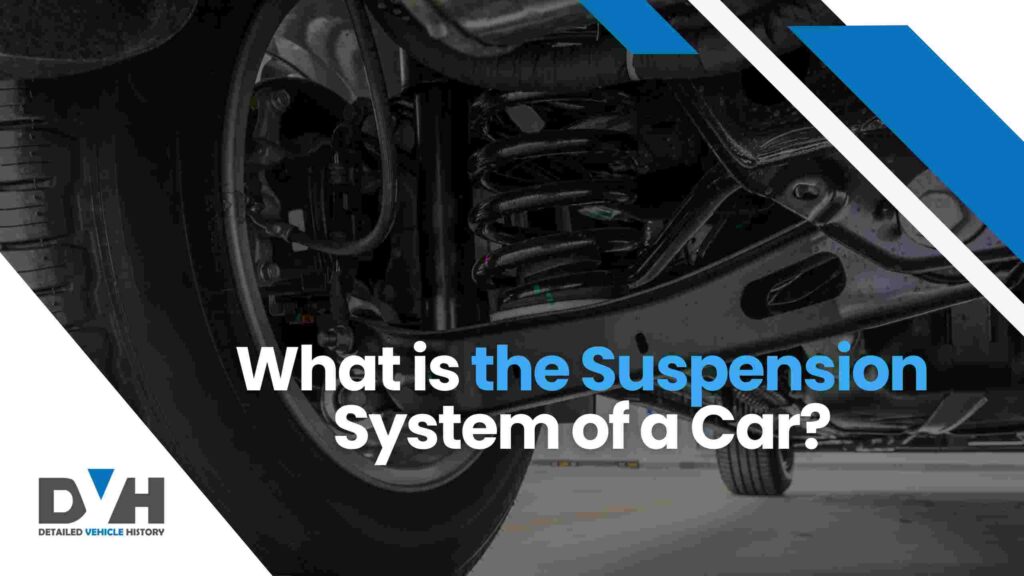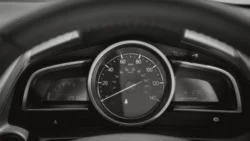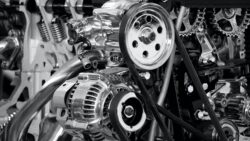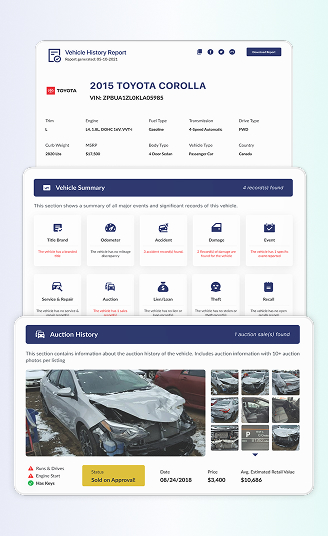A car suspension system consists of a spring, shock absorbers, and linkages that connect the wheels to the vehicle’s frame.
Key Takeaways:
- The car suspension system uses springs, shocks, and linkages to absorb bumps and keep the tires firmly on the road, which helps improve safety and control.
- Cars use two main suspension types, dependent and independent, and each one affects how the car handles different road conditions.
- Check the service records by VIN to see if the vehicle is serviced regularly, especially the suspension, to ensure its safety and comfort.
The purpose of suspension is to absorb bumps that might be caused by uneven roads and to ensure that the tires are in contact with the road surface. In addition to that, a car’s suspension helps to stabilise the car to provide a smooth and comfortable ride for its passengers during braking, cornering, and acceleration.
What Does a Suspension Do in a Car?
Car suspensions are designed to keep the car in a stable and smooth condition when it is driven it Its main purpose is to maximise the friction between the tires and road, even when the driving condition is not ideal. The suspension enables the driver to have better control of the vehicle and enhances overall passenger comfort.
Since not all roads are even, the suspension helps absorb the bumps, shocks, and vibrations that come from the wheels. Furthermore, the car’s suspension helps the wheel move up and down while keeping the car’s body stable.
In simpler terms, the car’s suspension system affects two main things: how smooth the car is and how well the car handles. The suspension helps the vehicle move over bumps without shaking too much and keeps it steady when turning, braking, or speeding up.
Three basic ideas explain how it works:
- Road isolation means the suspension keeps the car’s body steady, even when the road is rough or uneven.
- Road holding means the tires stay firmly on the ground, which is important for safe steering, braking, and acceleration.
- Cornering means the suspension helps the car stay balanced when turning, so it doesn’t lean too much to one side.
Together, these features make driving smoother, safer, and more comfortable. Without a proper suspension system, even short trips could feel rough and difficult to control.
How Does a Car Suspension Work
A car’s suspension uses springs, shock absorbers, and linkages to absorb bumps, support the vehicle’s weight, and keep the tires in contact with the road. Springs take in impact energy, while shock absorbers control it to ensure a smooth, stable ride.
- Springs: Springs help absorb the impact when you drive over bumps or uneven roads. They support the car’s weight and allow the wheels to move up and down smoothly.
- Shock Absorbers: Shock absorbers work with the springs to prevent the car from bouncing too much after hitting a bump. They convert the energy from the springs into heat, helping to control the movement.
- Struts: Struts are similar to shock absorbers but also provide support for the car’s weight. They help keep the car stable and improve the steering.
- Anti-Roll Bars: Anti-roll bars help reduce body roll when turning, especially during sharp turns. They keep the car balanced and prevent it from leaning too much.
- Anti-Roll Bar Link Rods: These rods connect the anti-roll bar to the suspension system. They help transfer the forces from the wheels to the bar, reducing swaying.
- Bottom Suspension Arm: The bottom suspension arm links the wheels to the car’s body. It helps keep the wheels in proper alignment, ensuring a smooth ride.
- Top Strut Mount: The top strut mount connects the strut to the car’s body. It helps absorb road shocks and improve the comfort of the ride.
Here’s what happens in real time when the car encounters a bump or a dip:
- The wheel moves upward, and the spring compresses to absorb the shock.
- The damper slows down the spring’s rebound to stop the car from bouncing repeatedly.
- The linkages and anti-roll bar manage how the wheels move relative to each other, keeping the body balanced and preventing excessive tilt.
Essentially, the suspension turns what would be a harsh impact into a gentle motion that drivers and passengers barely notice.
Why Does a Car Suspension Matter?
A car’s suspension system is important because it affects ride comfort and handling. It helps keep the tires in contact with the road, improving safety and control while driving.
- Optimises Control: Keeps tires firmly planted on the road surface, ensuring maximum grip and control during manoeuvres.
- Ensures Stability: Prevents excessive body roll and maintains the car’s level stance during braking, accelerating, and turning.
- Improves Comfort: Absorbs road shock, effectively minimising vibrations and bumps to deliver a consistently smooth ride.
- Enhances Safety: Allows for quick and accurate steering response, which is crucial for accident avoidance.
- Modern Adjustments: Advanced suspension systems can automatically adjust stiffness and ride height to match road conditions and driving style.
Car Suspension Types
Car suspension does not have only one type, but actually it has two main types. Their usage depends on what type of car; if the car is intended for challenging terrain, the suspension must be different from a city car.
- Independent: The independent suspension lets each wheel have its own assembly, meaning that each of them can move up and down independently without interrupting other wheels. This system offers a more comfortable driving experience and is suitable for modern vehicles.
- Dependent: The dependent type of suspension uses rigid axles that stretch across the car’s body to connect with the wheels. Because of the design, this type of suspension is suitable for rough terrain.
Aside from these two suspension types, a car also has another two suspension types, such as:
- Semi-Independent Suspension: A mix between dependent and independent systems. Each wheel has some freedom to move, but they’re still connected. Found in smaller cars that need a balance between comfort and cost.
- Air Suspension: Uses air-filled bags instead of metal springs. It can raise or lower the car depending on the load or road conditions. Found in luxury and heavy-duty vehicles. Offers a smooth, adjustable ride.
Get the window sticker to learn about the car’s mechanical features, including the suspension type, so you know exactly how it handles and performs.
How to Check Suspension on a Car
A quick check of your suspension can help you spot early signs of wear before it turns into bigger problems. Here are three simpler ways to check the car’s suspension that you can do at home.
Bounce Test
The bounce test helps to see the shock or strut condition of the vehicle.
- Park the car on a flat, level surface.
- Push down firmly on one corner of the car and release quickly.
- Watch how the car reacts if it bounces more than two or three times; the shocks or struts might be worn out and need replacing.
Wheel Play Test (with the car safely lifted)
This test helps detect problems in the ball joints, tie rods, or wheel bearings.
- For ball joints: Place your hands at the 12 and 6 o’clock positions on the tire. Push and pull to check for any movement or looseness.
- For tie rods: Grip the tire at the 9 and 3 o’clock positions and move it side to side. Any looseness can mean an issue with the steering linkage.
- For wheel bearings: Again, hold the tire at 12 and 6 o’clock. Push and pull; if you feel movement or hear a clunking sound, the wheel bearing or ball joint may be worn.
Visual Inspection
A simple visual check can reveal many suspension issues.
- Shocks and Struts: Look for signs of oil leaks, dents, or rust on the shock absorbers or struts.
- Springs: Check if the coil springs are cracked, corroded, or sagging.
- Tires: Uneven tread wear can indicate misalignment or suspension imbalance.
- Bushings: Inspect the control arms and sway bars for any worn, cracked, or missing rubber bushings.
What Causes Car Suspension Problems
Car suspension problems usually happen because of wear and tear, poor maintenance, overloading, or damage from road hazards. Key parts like shocks, struts, ball joints, and bushings can fail over time, leading to issues such as a rough ride, strange noises, difficulty steering, or uneven tire wear.
Common Causes
- General wear and tear: Over time, suspension parts naturally degrade. Shocks, struts, and bushings lose their effectiveness, making the ride less smooth and handling less precise.
- Poor maintenance: Skipping regular inspections or service allows small issues to worsen. For instance, leaking shocks or worn bushings can cause clunking sounds and reduced suspension performance.
- Overloading: Frequently carrying heavy loads puts extra stress on suspension components, accelerating wear and tear.
- Road hazards: Potholes, curbs, or debris can damage suspension parts directly and cause alignment problems.
Components That Can Fail
- Worn bushings: Cracked or deteriorated bushings create noise and reduce handling control.
- Worn ball joints: These allow smooth movement in the suspension, but when worn, they cause clunking sounds and steering instability.
- Worn sway bar links: If the rubber boot fails, dirt and moisture enter, causing wear and noise.
- Failed shocks or struts: Leaks, excessive bouncing, or banging noises often indicate worn or damaged shocks and struts.
Signs to Look For
- Rough or bouncy ride: Feeling excessive bumps or bouncing usually points to worn shocks or struts.
- Loud noises: Clunking, squeaking, or knocking over bumps can signal failing components.
- Difficulty steering: Pulling to one side or a loss of control when turning may indicate suspension problems.
- Uneven tire wear: Misaligned or improperly supported tires can wear unevenly.
- Leaking fluid: Puddles under the vehicle near the tires often mean hydraulic fluid is leaking from shocks or struts.
Suspension Tuning and Performance
A well-tuned suspension makes a big difference in how a car feels on the road. It’s not just about comfort or looks; tuning affects how the car handles turns, bumps, and braking.
Whether it’s a daily car or a performance build, proper tuning ensures the suspension matches the driving style and road conditions. It also helps tires wear evenly and improves stability during high-speed driving.
Why Tuning Matters
Tuning the suspension helps balance comfort and control. Mechanics adjust angles like camber, caster, and toe for different driving styles: daily driving, racing, or off-road.
Ride Comfort
Comfort depends on how well the suspension absorbs vibrations.
- Sedans usually have a softer setup (60–90 cycles per minute).
- Sports cars have stiffer setups (120–150 CPM) for sharper handling.
Real-Time Adjustment
Modern cars use active suspension systems that automatically adjust stiffness using sensors. This helps maintain comfort and control on different roads.
Car Suspension Maintenance and Troubleshooting
Even the best suspension setup needs regular care. Over time, rubber parts crack, oil seals leak, and metal components rust. Doing regular maintenance helps keep your suspension working smoothly and prevents bigger issues down the road.
Regular Checkups
Suspension parts wear out over time. Check them at least once a year or every 12,000 miles. Inspect:
- Shocks and struts for leaks
- Bushings for cracks
- Springs for rust or sagging
- Lubricate moving parts and replace anything worn out
The suspension system is important for both safety and comfort. It keeps the wheels on the road, absorbs bumps, and helps the car stay stable when turning, braking, or speeding up.
A working suspension improves handling, reduces uneven tyre wear, and makes the ride smoother, keeping both the car and passengers safe. That is why you should always check engine type before you sell or purchase a used car.
Car Suspension Types FAQs
How much does it cost to replace your suspension system?
Replacing a car’s suspension can cost anywhere from $150 to over $5,000, depending on the vehicle and the parts needed.
A basic shock replacement usually runs $200 to $800, while repairing or replacing a full suspension system, especially on a luxury car, can easily exceed $2,000. Labour costs and the type of suspension also affect the total price.
What is the most common problem with a suspension system?
The most common suspension problem is worn or leaking shocks and struts, which can make the ride bumpy, handling less stable, and the car bounce excessively. Other frequent issues include broken springs, worn bushings, damaged ball joints, and misaligned wheels, often caused by everyday wear or damage from potholes and rough roads.
Can I Drive My Car if the Suspension Has Failed?
No, it’s unsafe to drive with a broken suspension. A damaged suspension affects your car’s handling, stability, and braking, and in extreme cases, it can even lead to wheel detachment. Driving with this issue can also cause further damage to other parts of the vehicle. It’s best to have the car towed to a repair shop for inspection and repair.
What is the life span of a car transmission?
The lifespan of a car’s suspension depends on driving habits, road conditions, vehicle type, and the quality of its components. As a general guide:
- Shock absorbers and struts: 50,000 to 100,000 miles
- Control arms: 90,000 to 100,000 miles
Regular inspections and maintenance can help extend the life of your suspension and keep your ride safe and smooth
How long does a suspension last?
A car’s suspension components typically last between 50,000 and 100,000 miles, depending on factors such as driving conditions, vehicle type, and the quality of the parts used.









